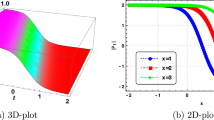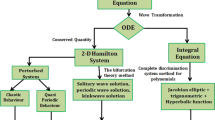Abstract
Inspired by Llibre and Vallls (in J. Math. Anal. Appl. 357:427–437, 2009), the conditions of center and isochronous center at the origin for a class of non-analytic quintic systems are studied in this paper. By a transformation, we first transform the systems into analytic systems, then sufficient and necessary conditions for the origin of the systems being a center are obtained. The fact that 11 limit circles could be bifurcated is proved. A complete classification of the sufficient and necessary conditions is given for the origin of the systems being an isochronous center.
Similar content being viewed by others
References
Lamarque, C., Touzé, C., Thomas, O.: An upper bound for validity limits of asymptotic analytical approaches based on normal form theory. Nonlinear Dyn. (2012). doi:10.1007/s11071-012-0584-y
Pascal, M.: New limit cycles of dry friction oscillators under harmonic load. Nonlinear Dyn. (2012). doi:10.1007/s11071-012-0545-5
Chavarriga, J., Giné, J., Garcia, I.: Isochronous centers of s linear center perturbed by fourth degree homogeneous polynomial. Bull. Sci. Math. 123, 77–96 (1999)
Chavarriga, J., Giné, J., Garcia, I.: Isochronous centers of s linear center perturbed by fifth degree homogeneous polynomial. Bull. Sci. Math. 126, 351–368 (2000)
Cairó, L., Giné, J., Llibre, J.: A class of reversible cubic systems with an isochronous center. Comput. Math. Appl. 38, 39–53 (1999)
Gasull, A., Manosa, V.: An explicit expression of the first Lyapunov and period constants with applications. J. Math. Anal. Appl. 211, 190–212 (1997)
Llibre, J., Valls, C.: Classification of the centers, their cyclicity and isochronicity for a class of polynomial differential systems generalizing the linear systems with cubic homogeneous nonlinearities. J. Differ. Equ. 246, 2192–2204 (2009)
Llibre, J., Valls, C.: Classification of the centers and isochronous centers for a class of quartic-like systems. Nonlinear Anal. 71, 3119–3128 (2009)
Llibre, J., Valls, C.: Classification of the centers, their cyclicity and isochronicity for the generalized quadratic polynomial differential systems. J. Math. Anal. Appl. 357, 427–437 (2009)
Llibre, J., Valls, C.: Classification of the centers, of their cyclicity and isochronicity for two classes of generalized quintic polynomial differential systems. Nonlinear Differ. Equ. Appl. 16, 657–679 (2009)
Liu, Y.: The generalized focal values and bifurcations of limit circles for quasi-quadratic system. Acta Math. Sin. 45, 671–682 (2002) (in Chinese)
Liu, Y., Li, J., Huang, W.: Singular Point Values, Center Problem and Bifurcations Os Limit Circles of Two Dimensional Differential Autonomous Systems, pp. 162–190. Science Press, Beijing (2009)
Liu, Y., Chen, H.: Formulas of singular point quantities and the first 10 saddle quantities for a class of cubic system. Acta Math. Appl. Sin. 25, 295–302 (2002) (in Chinese)
Liu, Y., Huang, W.: A new method to determine isochronous center conditions for polynomial differential systems. Bull. Sci. Math. 127, 133–148 (2003)
Liu, Y., Li, J.: Theory of values of singular point in complex autonomous differential system. Sci. China Ser. A 3, 245–255 (1989)
Liu, Y., Li, J.: Theory of values of singular point in complex autonomous differential system. Sci. China Ser. A 3, 245–255 (1989)
Acknowledgements
This research is partially supported by the National Nature Science Foundation of China (11201211, 11371373, 11101126) and Nature Science Foundation of Shandong Province (ZR2012AL04) and Applied Mathematics Enhancement Program of Linyi University.
Author information
Authors and Affiliations
Corresponding author
Appendices
Appendix A
The recursive formulas to compute singular point quantities at the origin of system (16):
c[0,0]=1;
when (k=j>0) or k<0, or j<0,
c[k,j]=0;
else
Appendix B
The recursive formulas to compute period constants of the origin of system (16):
c′[1,0]=d′[1,0]=1;c′[0,1]=d′[0,1]=0;
if k<0 or j<0 or (j>0 and k=j+1) then c′[k,j]=0,d′[k,j]=0;
else
Appendix C
The first eight point quantities at the origin of system (16) are as follows:
Case 1 When a 21 b 21 a 40 b 40≠0, let a 12=pb 21,b 12=pa 21,a 04=qb 40,b 04=qa 40, then
Subcase 1.1 Let \((-1+p)r(1+p-2r+2pr)\neq 0, a_{31}=ka_{21}^{2}, b_{31}=k b_{21}^{2}\),
If k≠0,q=1,
If k=0,q≠1,
Subcase 1.2 Let \(a_{31}b_{21}^{2}\neq a_{21}^{2}b_{31}, p=1\),
Case 2 When a 21 b 21≠0,a 40=b 40=0, let a 12=pb 21,b 12=pa 21, then
Subcase 2.1 Let \(a_{31}=ka_{21}^{2}, b_{31}=kb_{21}^{2}, p\neq1\)
where m=1,5 or \(\frac{7}{3}\).
Subcase 2.2 Let \(a_{31}b_{21}^{2}\neq a_{21}^{2}b_{31}, p=1\)
Case 3 When a 21=b 21=0,a 40 b 40≠0, let a 04=qb 40,b 04=qa 40, then
Subcase 3.1 When a 12 b 12≠0, let \(a_{31}=pb_{12}^{2}, b_{31}=pa_{12}^{2}\), then
If p=0,q≠1,
If q=1,p≠0,
Subcase 3.2 When a 12=b 12=0, then
Case 4 When a 21=b 21=a 40=b 40=0, then
Subcase 4.1 When a 12 b 12≠0, let \(a_{31}=pb_{12}^{2}\), \(b_{31}=pa_{12}^{2}\), then
Subcase 4.2 When a 12=b 12=0, then
Rights and permissions
About this article
Cite this article
Feng, L., Jianlong, Q. & Li, J. Bifurcation of limit cycles, classification of centers and isochronicity for a class of non-analytic quintic systems. Nonlinear Dyn 76, 183–197 (2014). https://doi.org/10.1007/s11071-013-1120-4
Received:
Accepted:
Published:
Issue Date:
DOI: https://doi.org/10.1007/s11071-013-1120-4




